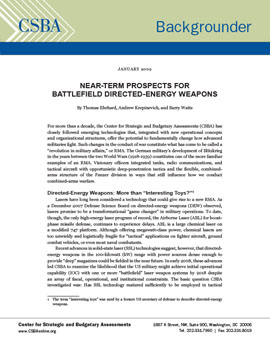
For more than a decade, the Center for Strategic and Budgetary Assessments (CSBA) has closely followed emerging technologies that, integrated with new operational concepts and organizational structures, offer the potential to fundamentally change how advanced militaries fight. Such changes in the conduct of war constitute what has come to be called a “revolution in military affairs,” or RMA. The German military’s development of Blitzkrieg in the years between the two World Wars (1918-1939) constitutes one of the more familiar examples of an RMA. Visionary officers integrated tanks, radio communications, and tactical aircraft with opportunistic deep-penetration tactics and the flexible, combined arms structure of the Panzer division in ways that still influence how we conduct combined- arms warfare.
Directed-Energy Weapons: More than “Interesting Toys?”
Lasers have long been considered a technology that could give rise to a new RMA. As a December 2007 Defense Science Board on directed-energy weapons (DEW) observed, lasers promise to be a transformational “game changer” in military operations. To date, though, the only high-energy laser program of record, the Airborne Laser (ABL) for boost phase missile defense, continues to experience delays. ABL is a large chemical laser on a modified 747 platform. Although offering megawatt-class power, chemical lasers are too unwieldy and logistically fragile for “tactical” applications on fighter aircraft, ground combat vehicles, or even most naval combatants.



























